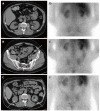Nephropathy in dietary hyperoxaluria: A potentially preventable acute or chronic kidney disease
- PMID: 25374807
- PMCID: PMC4220346
- DOI: 10.5527/wjn.v3.i4.122
Nephropathy in dietary hyperoxaluria: A potentially preventable acute or chronic kidney disease
Abstract
Hyperoxaluria can cause not only nephrolithiasis and nephrocalcinosis, but also renal parenchymal disease histologically characterized by deposition of calcium oxalate crystals throughout the renal parenchyma, profound tubular damage and interstitial inflammation and fibrosis. Hyperoxaluric nephropathy presents clinically as acute or chronic renal failure that may progress to end-stage renal disease (ESRD). This sequence of events, well recognized in the past in primary and enteric hyperoxalurias, has also been documented in a few cases of dietary hyperoxaluria. Estimates of oxalate intake in patients with chronic dietary hyperoxaluria who developed chronic kidney disease or ESRD were comparable to the reported average oxalate content of the diets of certain populations worldwide, thus raising the question whether dietary hyperoxaluria is a primary cause of ESRD in these regions. Studies addressing this question have the potential of improving population health and should be undertaken, alongside ongoing studies which are yielding fresh insights into the mechanisms of intestinal absorption and renal excretion of oxalate, and into the mechanisms of development of oxalate-induced renal parenchymal disease. Novel preventive and therapeutic strategies for treating all types of hyperoxaluria are expected to develop from these studies.
Keywords: Acute oxalate nephropathy; Acute tubular necrosis; Calcium oxalate nephrolithiasis; Chronic oxalate nephropathy; Dietary hyperoxaluria; Inflammasomes; Interstitial nephritis; Nephrocalcinosis; Oxalate transporters.
Figures



Similar articles
-
Chronic Nephropathy from Dietary Hyperoxaluria: Sustained Improvement of Renal Function after Dietary Intervention.Cureus. 2017 Mar 20;9(3):e1105. doi: 10.7759/cureus.1105. Cureus. 2017. PMID: 28435765 Free PMC article.
-
A hidden cause of oxalate nephropathy: a case report.J Med Case Rep. 2021 Mar 8;15(1):106. doi: 10.1186/s13256-021-02732-6. J Med Case Rep. 2021. PMID: 33678172 Free PMC article.
-
Resolution of acute kidney injury following intensive dialysis for oxalate nephropathy.Clin Nephrol. 2025 Jun 2. doi: 10.5414/CN111664. Online ahead of print. Clin Nephrol. 2025. PMID: 40454527
-
Recurrence of crystalline nephropathy after kidney transplantation in APRT deficiency and primary hyperoxaluria.Can J Kidney Health Dis. 2015 Sep 15;2:31. doi: 10.1186/s40697-015-0069-2. eCollection 2015. Can J Kidney Health Dis. 2015. PMID: 26380104 Free PMC article. Review.
-
Targeting kidney inflammation as a new therapy for primary hyperoxaluria?Nephrol Dial Transplant. 2019 Jun 1;34(6):908-914. doi: 10.1093/ndt/gfy239. Nephrol Dial Transplant. 2019. PMID: 30169827 Review.
Cited by
-
Case report: Acute oxalate nephropathy due to traditional medicinal herbs.Front Med (Lausanne). 2022 Dec 1;9:1063681. doi: 10.3389/fmed.2022.1063681. eCollection 2022. Front Med (Lausanne). 2022. PMID: 36530908 Free PMC article.
-
Association of Urinary Oxalate Excretion With the Risk of Chronic Kidney Disease Progression.JAMA Intern Med. 2019 Apr 1;179(4):542-551. doi: 10.1001/jamainternmed.2018.7980. JAMA Intern Med. 2019. PMID: 30830167 Free PMC article.
-
Acute oxalate nephropathy due to high vitamin C doses and exocrine pancreatic insufficiency.BMJ Case Rep. 2019 Nov 19;12(11):e231504. doi: 10.1136/bcr-2019-231504. BMJ Case Rep. 2019. PMID: 31748360 Free PMC article.
-
Oxalate, inflammasome, and progression of kidney disease.Curr Opin Nephrol Hypertens. 2016 Jul;25(4):363-71. doi: 10.1097/MNH.0000000000000229. Curr Opin Nephrol Hypertens. 2016. PMID: 27191349 Free PMC article. Review.
-
Chili Intake Is Inversely Associated with Chronic Kidney Disease among Adults: A Population-Based Study.Nutrients. 2019 Dec 4;11(12):2949. doi: 10.3390/nu11122949. Nutrients. 2019. PMID: 31817083 Free PMC article.
References
-
- Pak CY, Britton F, Peterson R, Ward D, Northcutt C, Breslau NA, McGuire J, Sakhaee K, Bush S, Nicar M, et al. Ambulatory evaluation of nephrolithiasis. Classification, clinical presentation and diagnostic criteria. Am J Med. 1980;69:19–30. - PubMed
-
- Larking P, Lovell-Smith CJ, Hocken AG. Urine oxalate levels in a New Zealand reference population and renal stone formers. N Z Med J. 1983;96:606–607. - PubMed
-
- Lindsjö M, Fellström B, Danielson BG, Kasidas GP, Rose GA, Ljunghall S. Hyperoxaluria or hypercalciuria in nephrolithiasis: the importance of renal tubular functions. Eur J Clin Invest. 1990;20:546–554. - PubMed
-
- Laminski NA, Meyers AM, Kruger M, Sonnekus MI, Margolius LP. Hyperoxaluria in patients with recurrent calcium oxalate calculi: dietary and other risk factors. Br J Urol. 1991;68:454–458. - PubMed
Publication types
LinkOut - more resources
Full Text Sources
Other Literature Sources
Miscellaneous

